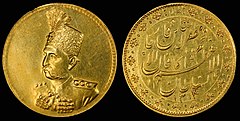Iranian toman

The Toman (Template:Lang-fa, pronounced [tomɑn]), is a superunit of the official currency of Iran, the rial. Toman, derived from a Mongolian word meaning ten thousand[1] (see tumen). It was divided into 10,000 dinar. Between 1798 and 1825, the toman was also subdivided into 8 rial, each of 1250 dinar. In 1825, the qiran was introduced, worth 1000 dinar or one tenth of a toman.
In 1932, the rial replaced the toman at a rate of 1 toman = 10 rials (i.e., 1 rial = 1 qiran). Although the rial is the official currency of Iran, Iranians employ the term 'toman', meaning 10 rials.
Coins
Iranian gold coins were denominated in toman, with copper and silver coins denominated in dinar, rial or qiran. During the period of hammered coinage, gold toman coins were struck in denominations of ¼, ½, 1, 2 and 10 toman,[2] and later 1⁄5, 3 and 6 toman.[3] With the introduction of milled coinage in AH1295,[4] denominations included 1⁄5, ½, 1, 2, 5, 10, and 25 toman.[5] The last gold toman were issued in 1965, well after the toman had ceased to be an official Iranian currency.
Banknotes
In 1890, the Imperial Bank of Persia introduced notes in denominations of 1, 2, 3, 5, 10, 20, 25, 50, 100, 500 and 1000 toman.[6] These notes were issued until 1923. In 1924, a second series was introduced, consisting of 1, 2, 5, 10, 20, 50 and 100 toman notes[7] which were issued until the rial was introduced in 1932.[8] The higher-denomination notes were subject to frequent counterfeiting. Currently, since the worth of the toman has fallen so much the standard bank notes are 1,000; 2,000; 5,000; 10,000; 50,000; and 100,000 Rial notes.
German-issued World War I occupation notes
During World War I, a group of German and Turkish soldiers occupied a small portion of Iran until 1918. They circulated five different denominations of German Imperial Treasury notes (c. 1905) with a red overprint in Persian that were used locally.[9] In addition to the 12 qiran 10 shahi (5 Mark) and 25 qiran (10 Mark) notes pictured, the rest of the issue included: 5 Tomans (on a 20 Mark note), 25 Tomans (on a 100 Mark note), and 250 Tomans (on a 1,000 Mark note).[10] Wilhelm Wassmuss appears to be given credit for the occupation and issue of currency.[9]
External links
Notes
- ^ [1]
- ^ Cuhaj 2009a, p. 832.
- ^ Cuhaj 2009a, p. 837.
- ^ Cuhaj 2009a, p. 838.
- ^ Cuhaj 2009a, pp. 838–43.
- ^ Cuhaj 2010, pp. 710–11.
- ^ Cuhaj 2010, pp. 708–10.
- ^ Cuhaj 2010, p. 711.
- ^ a b Khandani, Babak, German Qaran and Toman, Fravahr.org, retrieved 25 May 2015
- ^ Cuhaj 2009b, pp. 699–70.
Sources
- Cuhaj, George S., ed. (2009a). Standard Catalog of World Gold Coins 1601–Present (6 ed.). Krause. ISBN 978-1-4402-0424-1.
{{cite book}}: Invalid|ref=harv(help) - Cuhaj, George S., ed. (2009b). Standard Catalog of World Paper Money Specialized Issues (11 ed.). Krause. ISBN 978-1-4402-0450-0.
{{cite book}}: Invalid|ref=harv(help) - Cuhaj, George S., ed. (2010). Standard Catalog of World Paper Money General Issues (1368-1960) (13 ed.). Krause. ISBN 978-1-4402-1293-2.
{{cite book}}: Invalid|ref=harv(help)



